Growth and Temperature Properties of the Phase-Matching Angle of 23% Deuterated ADP Crystal
Abstract
1. Introduction
2. Materials and Methods
2.1. Materials
2.1.1. Retracing Curve
2.1.2. Crystal Growth
2.1.3. Sample Preparation
2.2. Sample Characterizations
2.2.1. Raman Spectroscopy
2.2.2. Crystalline Perfection
3. Experimental Set-Up
4. Results and Discussion
4.1. PM Angle Changes
4.2. Variation in Spectral Bandwidth before and after the Crystals
5. Conclusions
Author Contributions
Funding
Institutional Review Board Statement
Informed Consent Statement
Data Availability Statement
Acknowledgments
Conflicts of Interest
References
- Praveen, B.; Saravanan, M. Second harmonic generation, optical, thermal, piezoelectric and mechanical properties of adipic acid-doped ADP crystal. J. Nonlinear Opt. Phys. 2021, 30, 2150008. [Google Scholar] [CrossRef]
- Kumari, R.A. Optical and SHG Measurements of Aminoacids doped ADP NLO crystals. MRS Adv. 2020, 5, 1955–1963. [Google Scholar] [CrossRef]
- Priyadharshini, R.S.; Saravanan, M. An extensive investigation of crystalline, nonlinear, piezoelectric, optical, phase purity and electro-optic properties of doped ammonium dihydrogen phosphate single crystals. J. Nonlinear Opt. Phys. 2023, 2350069. [Google Scholar] [CrossRef]
- Kaminskii, A.A.; Dolbinina, V.V.; Rhee, H.; Eichler, H.J.; Ueda, K.; Takaichi, K.; Shirakawa, A.; Tokurakawa, M.; Dong, J.; Jaque, D. Nonlinear-laser effects in NH4H2PO4 (ADP) and ND4D2PO4 (DADP) single crystals: Almost two-octave multi-wavelength Stokes and anti-Stokes combs, cascaded lasing in UV and visible ranges with the involving of the second and third harmonic generation. Laser Phys. Lett. 2008, 5, 532. [Google Scholar] [CrossRef]
- Demos, S.G.; Raman, R.N.; Yang, S.T.; Negres, R.A.; Schaffers, K.I.; Henesian, M.A. Measurement of the Raman scattering cross section of the breathing mode in KDP and DKDP crystals. Opt. Express 2011, 19, 21050–21059. [Google Scholar] [CrossRef] [PubMed]
- Gorelik, V.S.; Kaminskii, A.A.; Melnik, N.N.; Sverbil, P.P.; Voinov, Y.P.; Zavaritskaya, T.N.; Zlobina, L.I. Spontaneous Raman scattering spectra of ADP and DADP crystals in different polarization schemes. J. Russ. Laser Res. 2008, 29, 357–363. [Google Scholar] [CrossRef]
- Sun, Y.; Ren, H.; Zhang, L.; Xu, M.; Wang, B.; Sun, X.; Wang, Z.; Xu, X. Spectral noncritical phase-matched frequency doubling crystal, partially deuterated ADP. Opt. Mater. Express 2019, 9, 216–222. [Google Scholar] [CrossRef]
- Begishev, I.A.; Brent, G.; Carey, S.; Chapman, R.; Kulagin, I.A.; Romanofsky, M.H.; Shoup, M.J.; Zuegel, J.D.; Bromage, J. High-efficiency, fifth-harmonic generation of a joule-level neodymium laser in a large-aperture ammonium dihydrogen phosphate crystal. Opt. Express 2021, 29, 1879–1889. [Google Scholar] [CrossRef]
- Lian, Y.F.; Zhu, L.L.; Huang, J.; Chai, X.X.; Cai, D.T.; Xu, M.X.; Sun, X.; Jiang, X.D. Nonlinear optical characteristics of DADP crystals with different deuterium. Opt. Mater. 2019, 91, 17–22. [Google Scholar] [CrossRef]
- Wang, M.X.; Wang, Z.P.; Chai, X.X.; Sun, Y.X.; Sui, T.T.; Sun, X.; Xu, X.G. Third-order nonlinear optical properties of ADP crystal. Mater. Res. Express 2018, 5, 056203. [Google Scholar] [CrossRef]
- Webb, M.S.; Eimerl, D.; Velsko, S.P. Wavelength insensitive phase-matched second-harmonic generation in partially deuterated KDP. J. Opt. Soc. Am. B 1992, 9, 1118–1127. [Google Scholar] [CrossRef]
- Kirby, K.W.; DeShazer, L.G. Refractive indices of 14 nonlinear crystals isomorphic to KH2PO4. J. Opt. Soc. Am. B 1987, 4, 1072–1078. [Google Scholar] [CrossRef]
- Zernike, F. Refractive indices of ammonium dihydrogen phosphate and potassium dihydrogen phosphate between 2000 Å and 1.5 μm. J. Opt. Soc. Am. 1964, 54, 1215–1220. [Google Scholar] [CrossRef]
- Zhu, L. Study on the Growth and Properties of (D)ADP Crystals. Ph.D. Thesis, Shandong University Institute of Crystal Materials, Jinan, China, 2015; pp. 91–100. [Google Scholar]
- Gao, H.; Teng, B.; Wang, Z.; Zhong, D.; Wang, S.; Tang, J.; Ullah, N.; Ji, S. Room temperature noncritical phase matching fourth harmonic generation properties of ADP, DADP, and DKDP crystals. Opt. Mater. Express 2017, 7, 4050–4057. [Google Scholar] [CrossRef]
- Li, G.; Su, G.; Zhuang, X.; He, Y.; Li, Z. Growth of Deuterated Ammonium Dehydrogen Phosphate (DADP) Crystal from Solution and Its Characterization. J. Synth. Cryst. 2004, 33, 192–196. [Google Scholar]
- Zhu, L.; Gan, X.; Zhang, Q.; Liu, B.; Xu, M.; Zhang, L.; Xu, X.; Gu, Q.; Sun, X. Electrical conduction in Deuterated Ammonium Dihydrogen Phosphate crystals with different degrees of deuteration. Chin. Phys. Lett. 2015, 32, 057201. [Google Scholar] [CrossRef]
- Sunagawa, I. Crystals: Growth, Morphology, & Perfection; Cambridge University Press: Cambridge, UK, 2005; p. 56. [Google Scholar]
- Burton, J.A.; Prim, R.C.; Slichter, W.P. The distribution of solute in crystals grown from the melt. Part I. Theoretical. J. Chem. Phys. 1953, 21, 1987–1991. [Google Scholar] [CrossRef]
- Leroudier, J.; Zaccaro, J.; Debray, J.; Segonds, P.; Ibanez, A. Rapid Growth in Solution of a Solid Solution under Stationary Conditions. Cryst. Growth Des. 2013, 13, 3613–3620. [Google Scholar] [CrossRef]
- Dorrer, C.; Begishev, I.A.; Bahk, S.W.; Bromage, J. Characterization of partially deuterated KDP crystals using two-wavelength phase-matching. Opt. Mater. Express 2021, 11, 774–790. [Google Scholar] [CrossRef]
- Ji, S.; Teng, B.; Kong, W.; Zhong, D.; Sun, X.; Wang, Z. The effect of supersaturation levels on the segregation coefficient of deuterium in K (H1−xDx)2PO4 crystals using Raman spectroscopy. CrystEngComm 2016, 18, 971–976. [Google Scholar] [CrossRef]
- Yakshin, M.A.; Kim, D.W.; Kim, Y.S.; Broslavets, Y.Y.; Sidoryuk, O.E.; Goldstein, S. Determination of the deuteration degree of DKDP crystals by Raman spectroscopy technique. Laser Phys. 1997, 7, 941–945. [Google Scholar]
- Ding, J. Influence of MO42− (M = Cr, Mo, W) Anions on Growth and Optical Properties of KDP Crystal and High Temperature Behavior of KDP Crystal. Ph.D. Thesis, Shandong University, Jinan, China, 2011. [Google Scholar]
- Ji, S.; Li, F.; Wang, F.; Xu, X.; Wang, Z.; Sun, X. Homogeneity of rapid grown DKDP crystal. Opt. Mater. Express 2014, 4, 997–1002. [Google Scholar] [CrossRef]
- Sun, F.; Zhang, P.; Lu, L.; Xiang, Y.; Bai, Q. The effect of air flow on the temperature distribution and the harmonic conversion efficiency of the ADP crystal with large aperture in the temperature control scheme. Opt. Laser Technol. 2016, 77, 126–133. [Google Scholar] [CrossRef]
- Ghosh, G.; Bhar, G. Temperature dispersion in ADP, KDP, and KD* P for nonlinear devices. IEEE J. Quantum Electron. 1982, 18, 143–145. [Google Scholar] [CrossRef]
- Wang, W.; Li, K.Y.; Wang, J.; Han, W.; Wang, F.; Xiang, Y.; Feng, B. Analysis on dependence of phase matching angle on temperature in KDP crystal. Opt. Laser Technol. 2011, 43, 683–686. [Google Scholar] [CrossRef]
- Hagen, W.F.; Magnante, P.C. Efficient Second-Harmonic Generation with Diffraction-Limited and High-Spectral-Radiance Nd-Glass Lasers. J. Appl. Phys. 1969, 40, 219–224. [Google Scholar] [CrossRef]

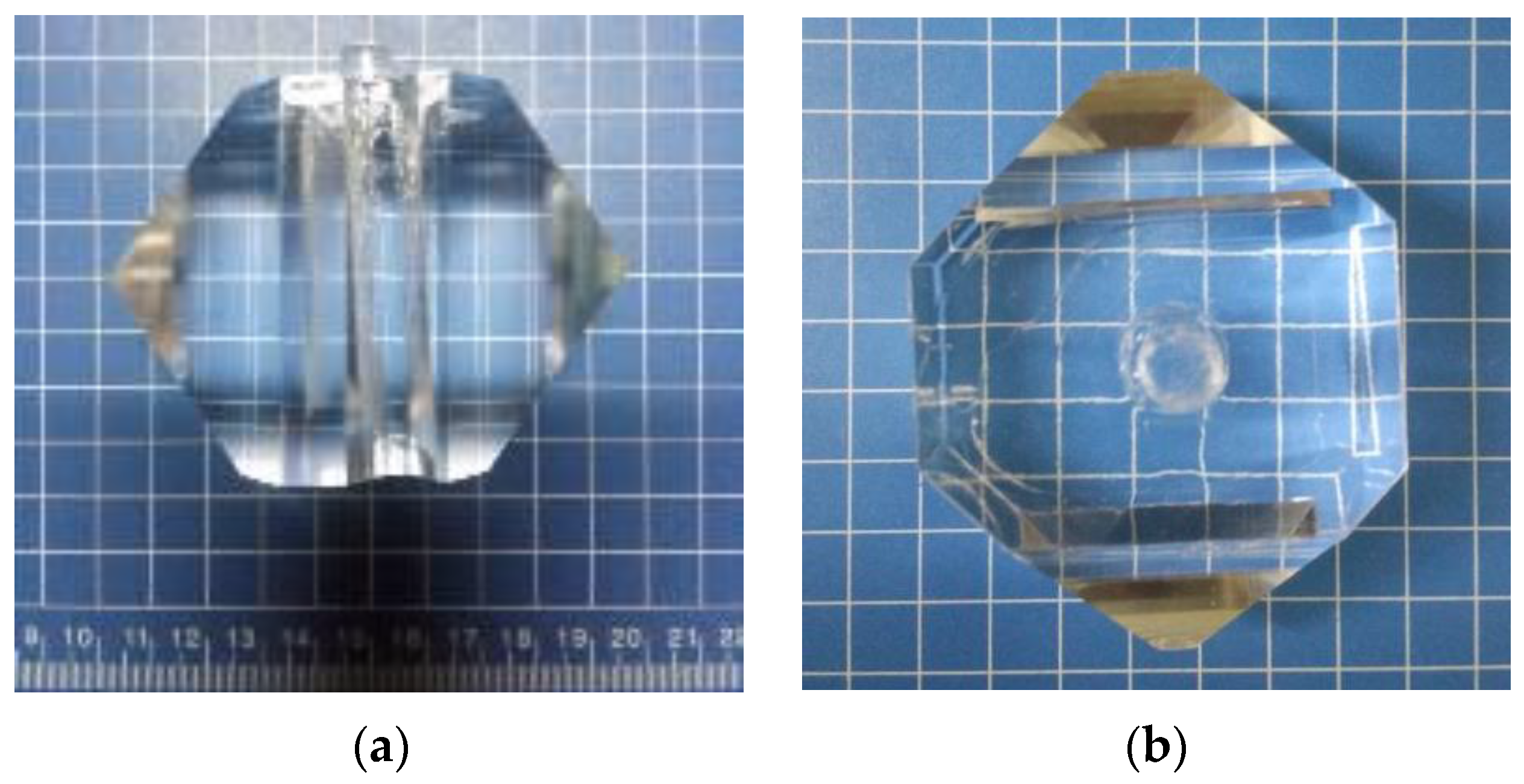

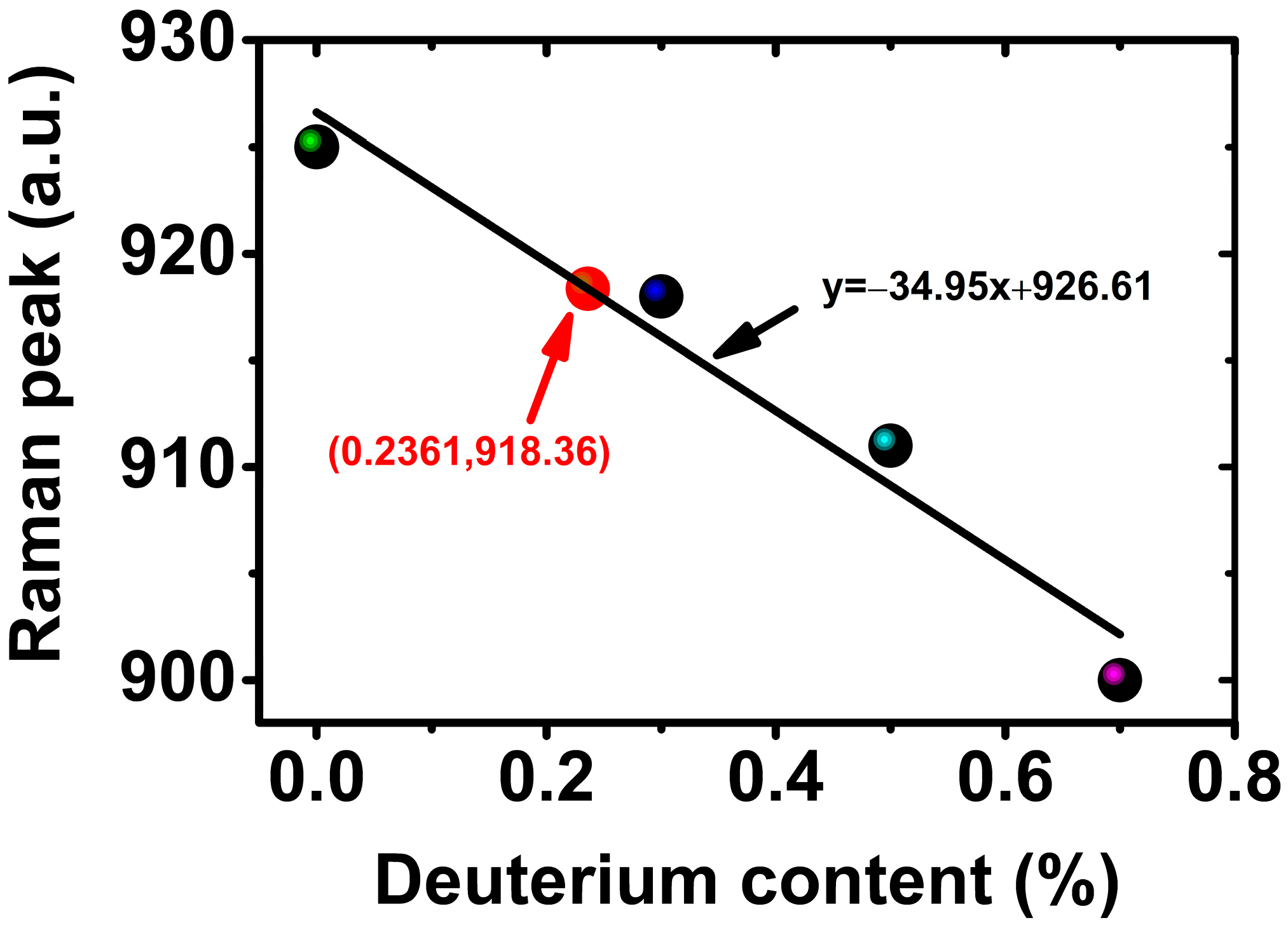
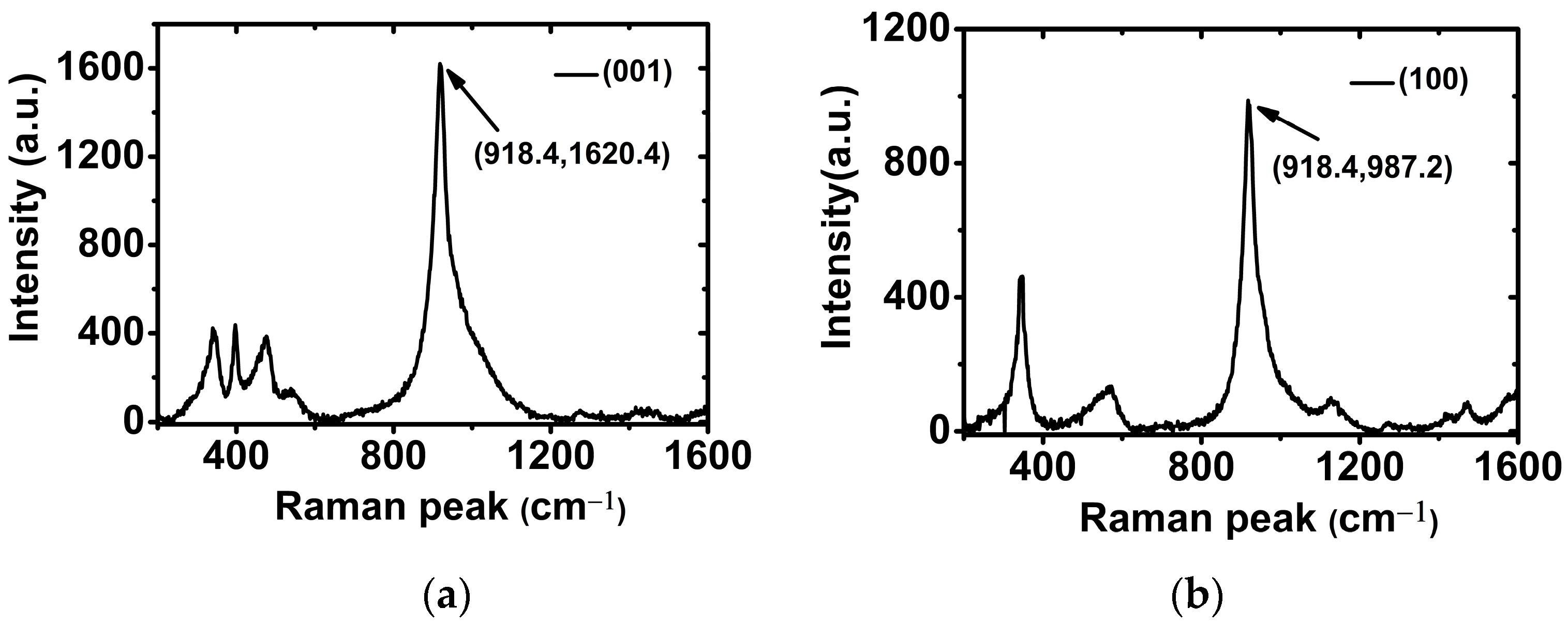
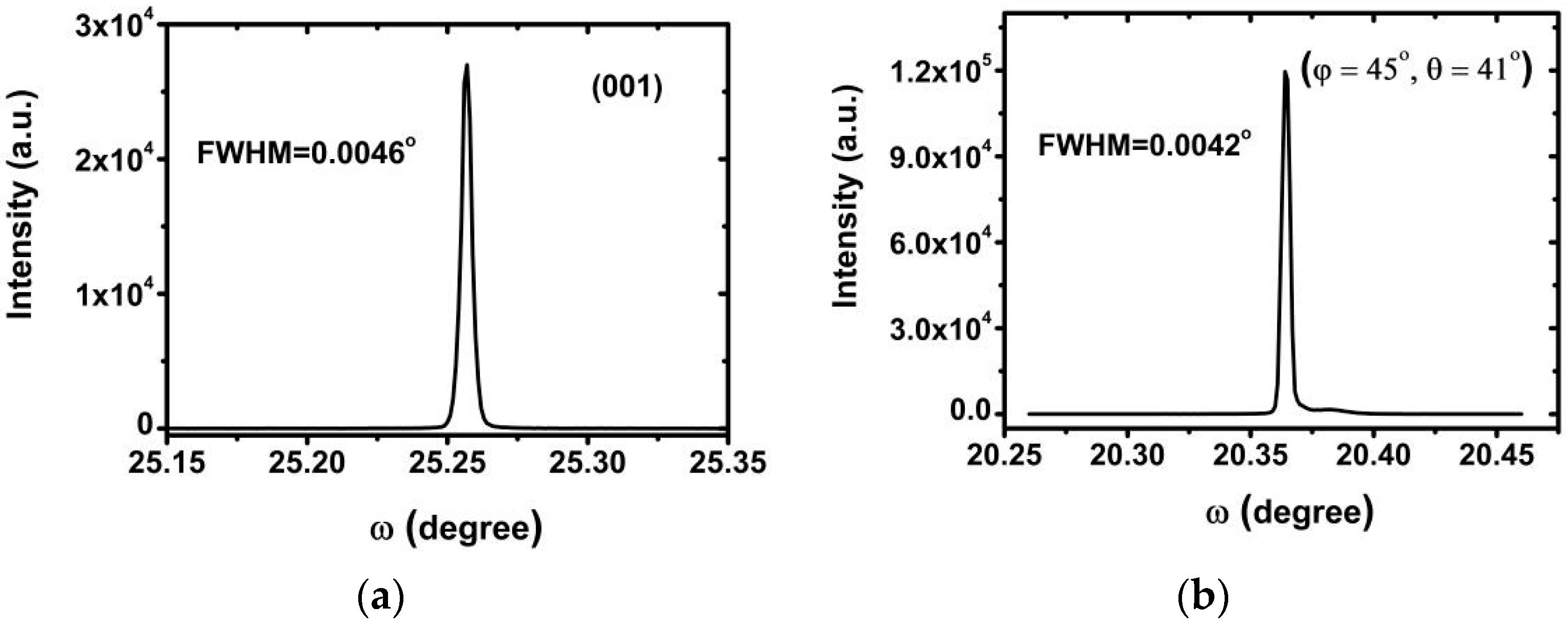
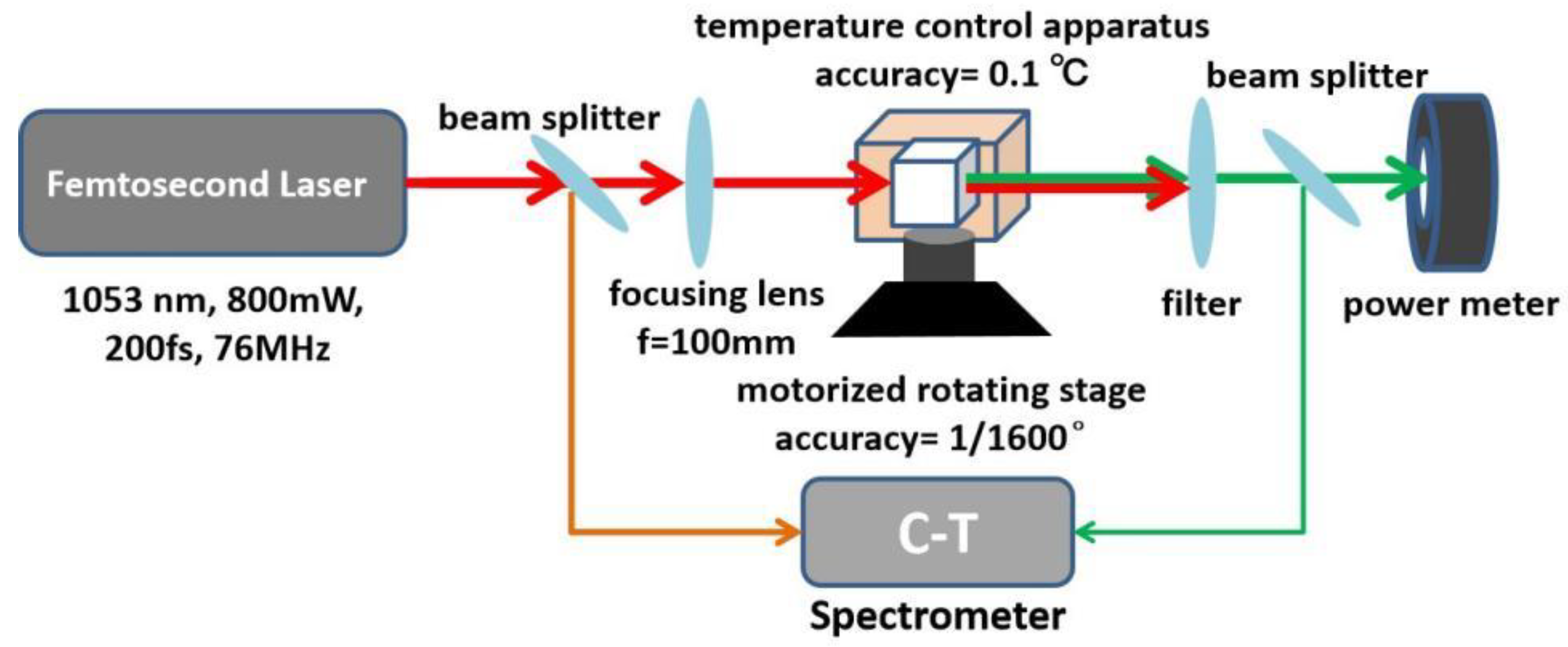
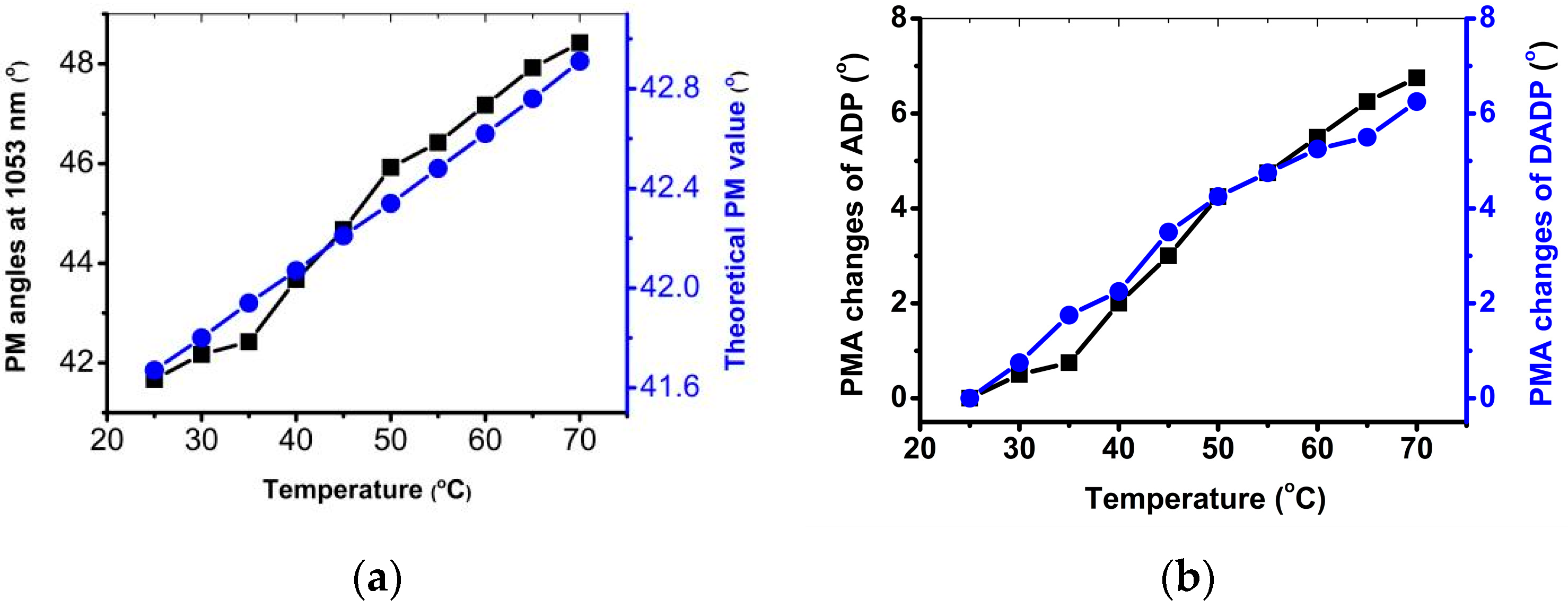

| Wavelength (μm) | Sample | α0 cm−1 | β cm GW−1 (×10−2) | n2 cm2 W−1 (×10−16) | Imχ3 esu (×10−16) | Reχ3 esu (×10−16) | χ3 esu (×10−16) |
|---|---|---|---|---|---|---|---|
| 1.064 [10] | ADP-I | 0.78 | 0.23 | - | 0.68 | - | - |
| ADP-II | 0.70 | 0.23 | - | 0.70 | - | - | |
| 0.532 [10] | ADP-I | 0.83 | 0.75 | 1.76 | 1.14 | 1.00 | 1.52 |
| ADP-II | 0.73 | 0.92 | 1.34 | 1.40 | 0.77 | 1.60 | |
| 0.355 [9,10] | ADP-I | 0.99 | 0.78 | 2.01 | 0.82 | 1.18 | 1.44 |
| ADP-II | 0.80 | 1.08 | 1.37 | 1.13 | 0.80 | 1.38 | |
| 30%DADP-I | - | 8.01 | 48.8 | 0.086 | 0.030 | 0.091 | |
| 50%DADP-I | - | 9.99 | 59.0 | 0.107 | 0.036 | 0.113 |
Disclaimer/Publisher’s Note: The statements, opinions and data contained in all publications are solely those of the individual author(s) and contributor(s) and not of MDPI and/or the editor(s). MDPI and/or the editor(s) disclaim responsibility for any injury to people or property resulting from any ideas, methods, instructions or products referred to in the content. |
© 2024 by the authors. Licensee MDPI, Basel, Switzerland. This article is an open access article distributed under the terms and conditions of the Creative Commons Attribution (CC BY) license (https://creativecommons.org/licenses/by/4.0/).
Share and Cite
Sun, Y.; Ren, H.; Zhuang, S.; Wang, X. Growth and Temperature Properties of the Phase-Matching Angle of 23% Deuterated ADP Crystal. Materials 2024, 17, 273. https://doi.org/10.3390/ma17020273
Sun Y, Ren H, Zhuang S, Wang X. Growth and Temperature Properties of the Phase-Matching Angle of 23% Deuterated ADP Crystal. Materials. 2024; 17(2):273. https://doi.org/10.3390/ma17020273
Chicago/Turabian StyleSun, Yuxiang, Hongkai Ren, Shidong Zhuang, and Xinle Wang. 2024. "Growth and Temperature Properties of the Phase-Matching Angle of 23% Deuterated ADP Crystal" Materials 17, no. 2: 273. https://doi.org/10.3390/ma17020273
APA StyleSun, Y., Ren, H., Zhuang, S., & Wang, X. (2024). Growth and Temperature Properties of the Phase-Matching Angle of 23% Deuterated ADP Crystal. Materials, 17(2), 273. https://doi.org/10.3390/ma17020273




